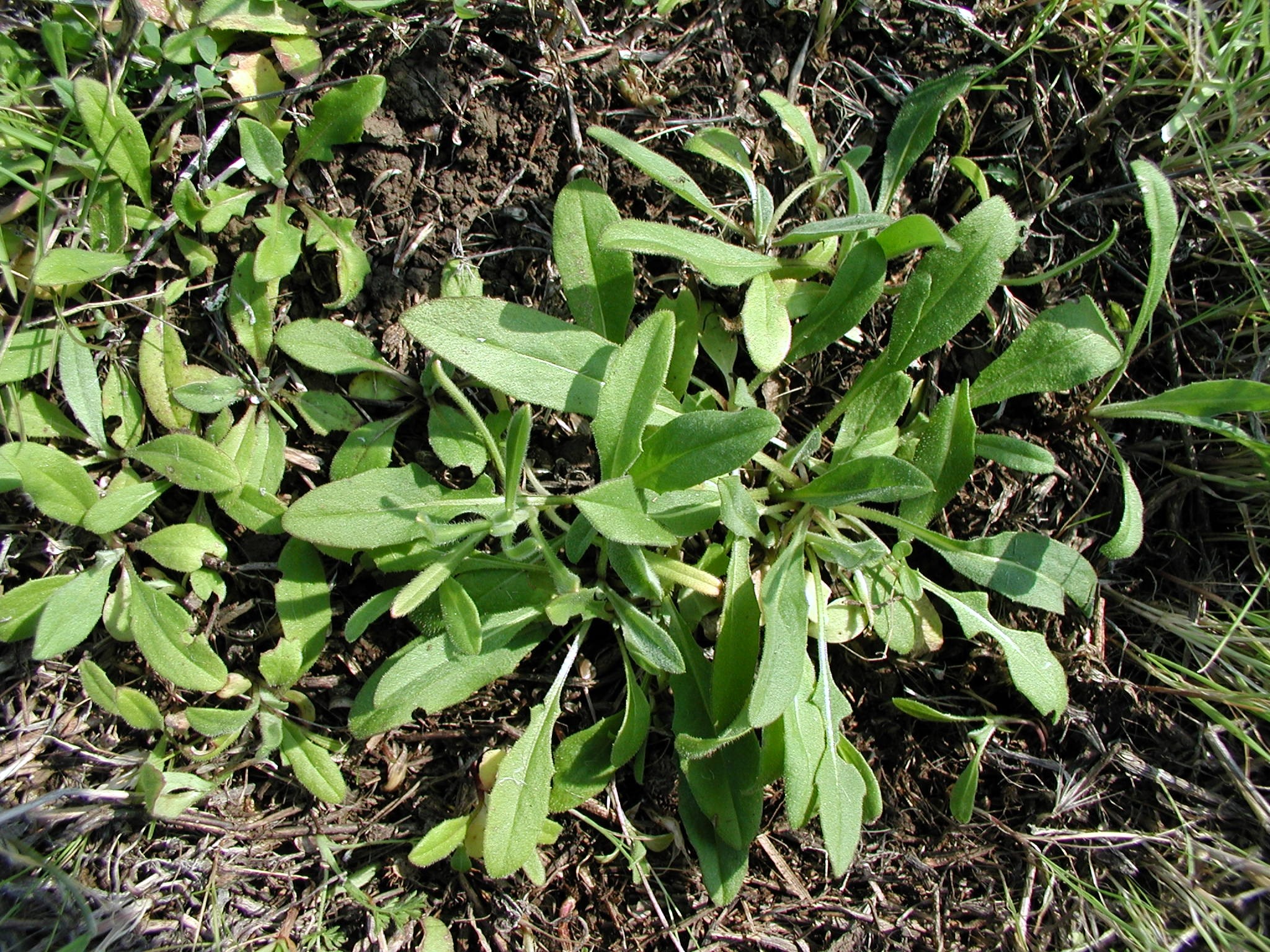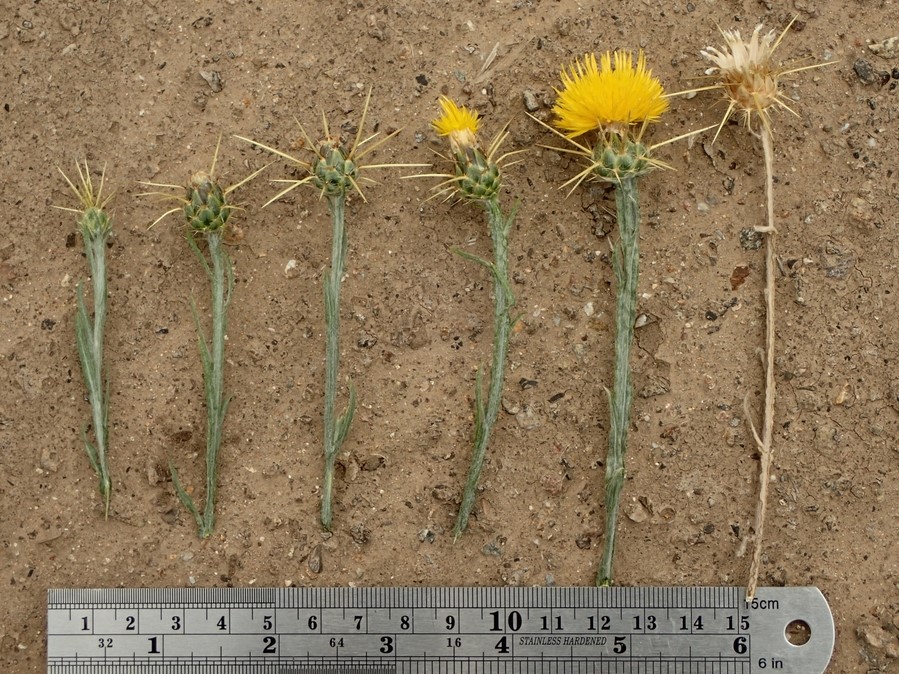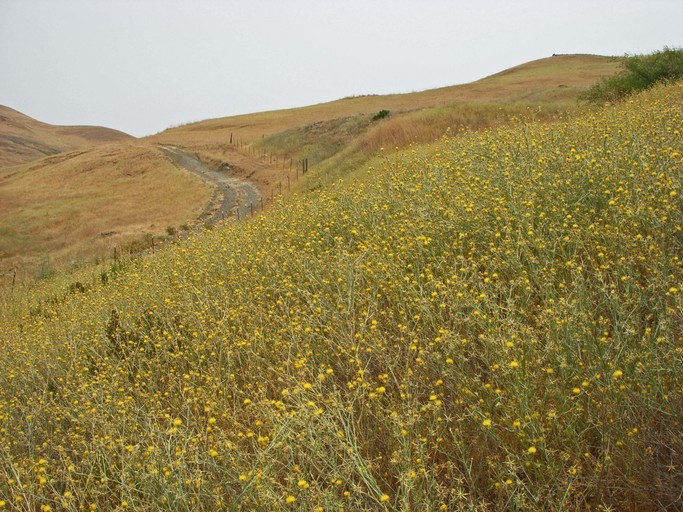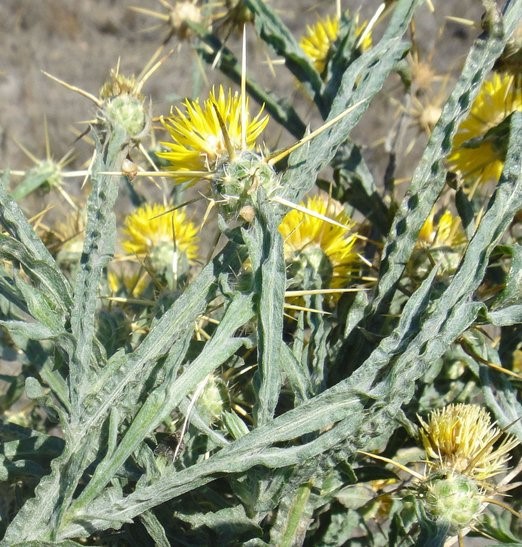Centaurea solstitialis
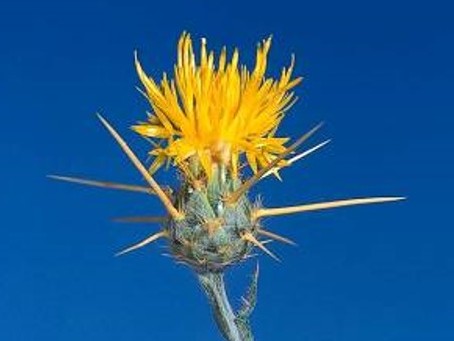
Common names: yellow starthistle
Centaurea solstitialis (yellow starthistle) is a bushy winter annual (family Asteraceae) from the Mediterranean region in Europe that has invaded over 12 million acres in California. Yellow starthistle inhabits open hills, grasslands, open woodlands, fields, roadsides, and rangelands, and it is considered one of the most serious rangeland weeds in the state. It propagates rapidly by seed, and a large plant can produce nearly 75,000 seeds. Plants are gray-green in color and produce yellow flower heads armed with stiff, long spines in late June and July. Several insects from the Mediterranean region, including weevils and flies, have been employed as biocontrol agents for yellow starthistle with minor success.
Cal-IPC Rating: High?CDFA Rating: -*?
Assessment(s)
Centaurea solstitialis Plant Assessment Form - Information gathered by Cal-IPC on the impacts, rate of spread, and distribution of invasive plants in California. Does not include management information.
Species ID Card
Invasive Species ID Card - To support field identification of early detection species, Cal-IPC has designed a set of Species ID cards that can be downloaded, printed double-sided, and trimmed to size.
Special Reports
- Yellow Starthistle Management Guide - Provides a comprehensive overview of treatment methods for yellow starthistle, including each method's advantages and disadvantages, timing, and best fit in a strategic management plan.
- Pest Notes on Yellow Starthistle - from the University of California's Statewide Integrated Pest Management Program
Weed Management Notes
- Management Notes - Information on management techniques and effectiveness from the University of California Cooperative Extension’s Weed Research & Information Center.
Cal-IPC Newsletter Articles
- Releasing a new biological control agent for yellow starthistle. Smith, Lincoln. Vol 30, Issue 3
- Are we making progress? A bird's-eye view of change in invasive plant cover in central-coastal Orange County. Burger, Jutta C.. Vol 27, Issue 2
- Weed worker legend Joe DiTomaso retires. Brusati, Elizabeth. Vol 25, Issue 2
- Yellow starthistle and water supply: An experiment. Meral, Jerry. Vol 25, Issue 1
- Weeds and climate resilience in Sierra meadows. Brusati, Elizabeth; Johnson, Doug. Vol 24, Issue 1
- AB 2402: The rocky road to WMA funding. Johnson, Doug. Vol 22, Issue 2
- Protection of ecosystem services: A way forward after Weed Management Area cuts. Funk, Jennifer L.; Matzek, Virginia; Johnson, Doug. Vol 22, Issue 1
- Weed biological control agents approved for California. Pitcairn, Michael J.; Smith, Lincoln; Moran, Patrick. Vol 22, Issue 1
- Prescribed grazing for invasive plant control on rangelands. Davy, Josh; Tate, Kenneth; Roche, Leslie. Vol 21, Issue 3
- Taking to the air to locate, prioritize and treat effectively. Burger, Jutta C.. Vol 21, Issue 2
- New 3rd edition: "Prevention BMPs for Land Managers". Bakke, David. Vol 20, Issue 4
- The butterfly effect. Trumbo, Joel. Vol 20, Issue 2
- USFWS and PG&E partner to protect species. Terrazas, Louis. Vol 20, Issue 1
- Prioritizing Regional Response to Invasive Plants in the Sierra Nevada. Brusati, Elizabeth; Morawitz, Dana; Powell, Cynthia. Vol 19, Issue 2
- Symposium at the “Gateway to the Sequoias”. editor. Vol 17, Issue 3
- Wildland Weed News. editor. Vol 17, Issue 2
- The cost of weeds to California. Brusati, Elizabeth. Vol 17, Issue 1
- East Bay volunteers head to the hills and the shores. Schwartz, Susan. Vol 16, Issue 4
- Stopping yellow starthistle at its leading edge. West, Wendy. Vol 16, Issue 4
- Shasta County citizens take on weeds. Dozier, Melissa. Vol 14, Issue 4
- An island called Santa Cruz: Removing invasives on the Channel Islands. Owen, Ken. Vol 12, Issue 2
- Development and release of a plant pathogen as a new biological control of yellow starthistle. Woods, Dale. Vol 12, Issue 2
- Teaching weeds: California university invasive plant programs. Cole, Kristie; Molinari, Nicole. Vol 12, Issue 2
- Fighting weeds in the Tahoe basin. Donaldson, Sue. Vol 11, Issue 2
- Exploring alternative methods for vegetation control and maintenance along roadsides. Young, Steve L.. Vol 10, Issue 4
- New remote sensing tool under evaluation. Horney, Marc. Vol 10, Issue 4
- Current cartography: First reports of yellow starthistle by county. CalEPPC. Vol 10, Issue 3
- Viewing invasive species removal in a whole-ecosystem context. Zavaleta, Erika S.; Hobbs, Richard J.; Mooney, Harold A.. Vol 10, Issue 3
- Exotic pest plants, Calif. Assoc. of Nurserymen, and CalEPPC. Bell, Carl E.; Evans, Mike; Wilen, Cheryl. Vol 09, Issue 1
- Results of the CalEPPC questionnaire at Symposium ’98 in Ontario. DiTomaso, Joe. Vol 06, Issue 4
- Killing the beast: A cooperative approach for control of Arundo donax in the Santa Ana River watershed. Stein, Eric D.; Vartanian, Valerie. Vol 05, Issue 3
- Lessons from the front: Taking stock to avoid surprises. Kelly, Mike. Vol 05, Issue 1
- The use of fire for yellow starthistle (Centaurea solstitialis) management and restoration of native grasslands at Sugarloaf Ridge State Park. Hastings, Marla; DiTomaso, Joe. Vol 04, Issue 1
- Biological control of invasive exotic pest plant species: A report on the importance of maintaining and enhancing our nation’s biological control capabilities. CalEPPC. Vol 03, Issue 3
- Exotic pest plants of greatest ecological concern in California September 1994. Cal-IPC. Vol 02, Issue 4
- Yellow starthistle experimental group – report of the CalEPPC working group. Pitcairn, Mike. Vol 02, Issue 1
- California Exotic Pest Plant Council draft list exotic plants of greatest concern October 1993. CalEPPC. Vol 01, Issue 4
- Working group reports on weed control methods and applications for Arundo, french broom, german ivy, hoary cress, yellow starthistle, and pampasgrass. Cal-IPC. Vol 01, Issue 3
Cal-IPC Symposium Presentations
Presentations are linked where available. Where a presentation is not available, find more information by reading the abstract in the Cal-IPC Symposia Archive.
- Leveraging monitoring data to inform weed management in the world’s largest urban national park. Valliere, Justin; Parra, Olivia; Algiers, Joseph (2024)
- Biological control agents of weeds in California: Overview of rearing, releases, and monitoring by the CDFA Biological Control Program. Moran, Patrick (2023)
- Calling for a consortium on a rosette weevil against yellow starthistle in California. Park, Ikju (2023)
- The effect of yellow starthistle invasion on native plants and pollinators. Nelson, Rebecca (2023)
- Developing a post-fire EDRR framework. Quon, Lauren; Fitch, Robert; Laskey, Hailey (2022)
- Managing yellow starthistle in grazed and un-grazed areas on California’s Central Coast. Brooke, Jackson; Allred, Jenna (2022)
- Regional EDRR with Bay Area WMAs. Johnson, Doug; Valentine, Nicole (2022)
- Tackling invasive plants after the 2020 Angeles National Forest fire season. Castro, Andrew (2022)
- The role of fire in managing invasive species at the Santa Rose Plateau Ecological Reserve. Laskey, Hailey; Principe, Zach (2022)
- Update on recent biological control releases against invasive plants by the USDA-ARS. Moran, Patrick; Pratt, Paul; Smith, Lincoln (2022)
- A tale of two wildfires: post-fire weed management at Pepperwood Preserve. Friedfel, Devyn; Halbur, Michelle; Gillogly, Michael; Barringer, Sonja; Comendant, Tosha (2020)
- A test of the herbicide Weed Slayer for the control of invasive plants. Thomas, Don (2020)
- Biocontrol of yellow starthistle: mass-rearing the newly approved agent, Ceratapion basicorne, for release. Park, Ikju; Smith, Lincoln (2020)
- Fire management treatments leading to non-native plant invasions. Keeley, Jon (2020)
- Interactions among insects and weeds in western U.S. forests. Fettig, Christopher; Runyon, Justin; Trilling, Jared; Mortenson, Leif; Audley, Jackson (2020)
- Is yellow starthistle (Centaurea solstitialis) adapting to serpentine soils? Brafford, Katherine (2020)
- Two years after the fire: accomplishments in invasive plant control following the 2018 Woolsey Fire. Algiers, Joey (2020)
- Using detection dogs to enhance invasive plant management strategies. Hurt, Aimee (2020)
- Has yellow starthistle (Centaurea solstitialis) recently adapted to serpentine soils? Brafford, Katherine; Mesgaran, Mohsen (2019)
- Successes, failures, and lessons from the Orange County CNPS Emergent Invasive Program. Vanderhoff, Ron (2019)
- Weeds after Woolsey. Algiers, Joseph (2019)
- Mapping weeds and rare plants to inform management and conservation in the Zaca and Jesusita fires. Calloway, Stephanie; Schneider, Heather; Knapp, Denise (2018)
- Recent research on invasive weeds at the European Biological Control Laboratory (EBCL). Smith, Lincoln; Bon, Marie-Claude; Desurmont, Gaylord; Kashefi, Javid; Sforza, René; Tannières, Mélanie; Cristofaro, Massimo; Marini, Francesca; Goolsby, John; Rector, Brian; Vidovic, Biljana; Winkler, Daniel; Moran, Patrick (2018)
- Weed Management Areas: before, then, now & future. Schoenig, Steve (2018)
- Plant community responses to cattle grazing in a noxious weed-dominated rangeland. Roche, Leslie; Tate, Ken (2016)
- Stop-the-spread of yellow starthistle into the Sierra Nevada mountain range: Early detection and eradication on a regional scale (2.5 MB). West, Wendy (2008)
- Impacts of mowing and bud destruction on yellow starthistle root dynamics and flowering. Spencer, D. F.; Enloe, S. F.; Liow, I.; Chan, V.; Donovan, M.; Healy, E.; Pitcairn, M. (2004)
- Yellow starthistle management with grazing, mowing, and competitive plantings. Thomsen, Craig D.; Williams, William A.; Vayssieres, Marc P. (1996)
Other Centaurea solstitialis Information
- Bugwood - National database from the Center for Invasive Species and Ecosystem Health at the University of Georgia.
- CalPhotos - Images of plants taken mostly in California.
- Calflora - Distribution map and records of this species in California.
- CalWeedMapper - Distribution map of this species in California with ability to determine regional priorities.
- EDDMapS - Distribution of this species in North America.
- Jepson Interchange - Information on this plant's taxonomy, biology, and distribution from UC Berkeley's Jepson Herbarium.
- USDA PLANTS Database - Information on identification and distribution, with links to websites in individual states.
Additional photos
